ZTE ZTEMF332 Wireless Data Card User Manual Q78 ZTEMF332
ZTE Corporation Wireless Data Card Q78 ZTEMF332
ZTE >
User Manual
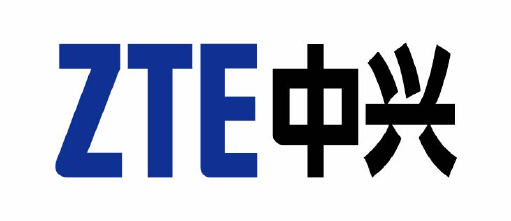
ZTE MF332
HSDPA/EDGE Card
User Manual
II
Copyright © 2007 by ZTE Corporation
All rights reserved.
No part of this publication may be excerpted, reproduced, translated or
utilized in any form or by any means, electronic or mechanical, including
photocopying and microfilm, without the prior written authorization of
ZTE Corporation.
Edition: 1st edition, Sep., 2007
.
III
Contents
1 Wireless Data Card Introduction...................................................... 1
1.1 Introduction ............................................................................... 1
1.2 Safety Warning and Notices...................................................... 2
1.3 Systems Supported................................................................... 3
1.4 PC System Requirements......................................................... 4
1.5 Data Card Technical Specification............................................ 4
2 Installation ......................................................................................... 5
2.1 Unpacking ................................................................................. 5
2.2 Appearance and Parts............................................................... 5
2.3 Software Installation.................................................................. 6
2.4 Running the Application ............................................................ 8
2.5 Safe Removal from your system............................................... 9
2.6 Software Uninstallation Process ............................................. 10
2.7 Hardware Set Up .....................................................................11
3 Using the Software Application ..................................................... 12
3.1 Software Introduction .............................................................. 12
3.2 Connecting to the Internet....................................................... 16
3.3 Making a Call .......................................................................... 17
3.4 Answering an Incoming Call.................................................... 18
3.5 Other Call Functions ............................................................... 18
3.6 SMS Messages....................................................................... 19
3.7 Create a New Message .......................................................... 19
3.8 Phone Book ............................................................................ 21
3.9 Settings ................................................................................... 23
3.10 Call Records ......................................................................... 29
3.11 Help....................................................................................... 29
4 FAQ & Answers ............................................................................... 30
5 Environmental Statement ............................................................... 33
1
1 Wireless Data Card Introduction
1.1 Introduction
Thank you for choosing the ZTE MF332 HSDPA/EDGE Card. To help
you use your card please read the manual carefully and keep it for
reference.
The pictures, symbols and contents in this manual are for reference only.
They might not be completely identical to your card. Please refer to the
actual device. The manufacturer operates a policy of continuous
development. We reserve the right to update and modify technical
specifications in this document at any time without prior notice.
The ZTE MF332 HSDPA/EDGE Card is a multi-mode 3G wireless data
card compatible with HSDPA, WCDMA, EDGE, GPRS, and GSM
networks. With PCMCIA II interface to connect to portable PC’s, it
integrates the functionality of a modem and a mobile phone and
combines mobile communication with the internet perfectly. It supports
data, audio and SMS services through the mobile phone network
helping you break away from limitations of fixed line connections,
location and network connectivity to communicate wirelessly anytime
and anywhere.

2
1.2 Safety Warning and Notices
To the owner
z The use of electronic transmitting devices is forbidden in aircraft, at
petrol stations and in hospitals. Please observe and obey all warning
signs and switch off your PC in these conditions.
z Operating a portable PC and data card may interfere with medical
devices like hearing aids and pacemakers.
z Be aware of warning signs in places such as oil refineries or chemical
factories where there are explosive gases or explosive products being
processed.
z Store the data card out of the reach of children. The data card may
cause injury if used as a toy or may be damaged by rough play or
moisture.
z This data card has been tested for compliance with FCC RF Exposure
(SAR) limits in the typical laptop computer configuration and this data
card can be used in desktop or laptop computers with side mounted
PCMCIA slots.
z This data card cannot be used with handheld PDAs (personal digital
assistants).
z This data card and its antenna must not be co-located or operated in
conjunction with any other antenna or transmitter.
z This data card complies with part 15 of the FCC Rules. Operation is
subject to the following two conditions:
(1) This data card may not cause harmful interference, and (2) this
data card must accept any interference received, including
interference that may cause undesired operation.
z This data card has been tested and found to comply with the limits for
a Class B digital device, pursuant to part 15 of the FCC Rules.
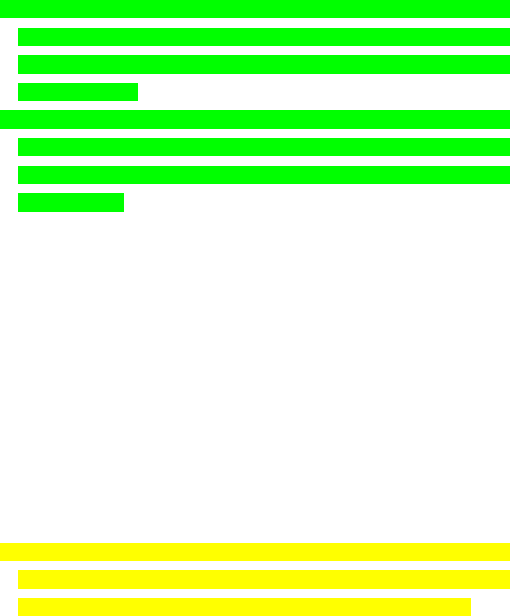
3
z This data card generates, uses and can radiate radio frequency
energy and, if not installed and used in accordance with the
instructions, may cause harmful interference to radio
communications.
z There is no guarantee that interference will not occur in a particular
installation. If this data card does cause harmful interference to radio
or television reception, which can be determined by turning the data
card off and on
Using your Data card
z Only use original accessories supplied by the manufacturer. Using
unauthorized accessories may invalidate your warranty.
z Avoid using the data card near or inside metallic structures or
establishments that can emit electromagnetic waves.
z The data card is not waterproof, please keep it dry and store it in a
cool place out of direct sunlight.
z Handle the data card with care. Don’t drop, bend, knock or treat it
harshly to avoid damage to the unit
z There are no user serviceable parts. Dismantling the unit will
invalidate the warranty.
z Do not attempt to disassemble the data card by yourself. Changes
and modifications made to the data card without the approval of
manufacturer could void your authority to operate this data card.
z Operating temperature range of 0℃~+55℃ and humidity 5%~95%
are recommended.
1.3 Systems Supported
The ZTE MF332 HSDPA/EDGE Card uses the PCMCIA II form factor
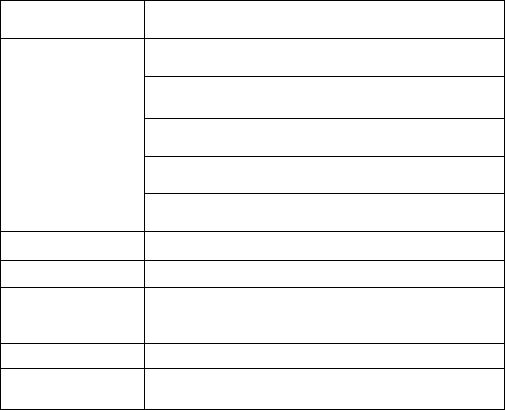
4
and supports most makes of portable PCs such as HP, Compaq, IBM,
Toshiba, LG, Dell, etc.
1.4 PC System Requirements
The data card and software application supports Windows 2000, XP and
Vista only with recommended specification:
CPU Pentium III or above
Hard Disk 20G or above
RAM 128M or above
1.5 Data Card Technical Specification
Network
Standards HSDPA/ WCDMA/ EDGE/ GPRS/ GSM
WCDMA/ HSDPA 850MHz: 824-849 MHz
869-894 MHz
WCDMA/HSDPA 2100MHz: 1920-1980 MHz
2110-2170 MHz
GSM/GPRS/EDGE 900MHz: 890-915 MHz
935-960 MHz
GSM/GPRS/EDGE 1800MHz:1710-1785 MHz
1805-1880 MHz
Frequency
Bands
GSM/GPRS/EDGE 1900MHz: 1850 -1910 MHz
1930 -1990 MHz
Dimensions 118×54×12 mm
Weight About 55g
Data Rates HSDPA mode max speed 3.6Mbps
WCDMA mode max speed 384 kbps
EDGE mode max speed 236.8kbps
Working Voltage 3.3V
Current
consumption Stand by: 80mA Max: 850mA
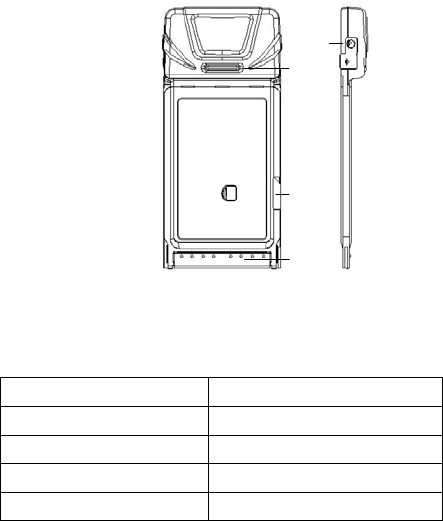
5
2 Installation
2.1 Unpacking
Check the following items are included in the package: ZTE MF332
HSDPA/EDGE Card, Headset, Software CD, Quick Start Guide and
Warranty Card.
2.2 Appearance and Parts
1. PCMCIA Interface 2. SIM/USIM Card Slot 3. LED Indicator
4. Headset Jack
LED Indicator Status:
LED Status
Green On Normal.
Red On Abnormal / No network signal
Green flashing Incoming Call
Green blinks four times New SMS Message
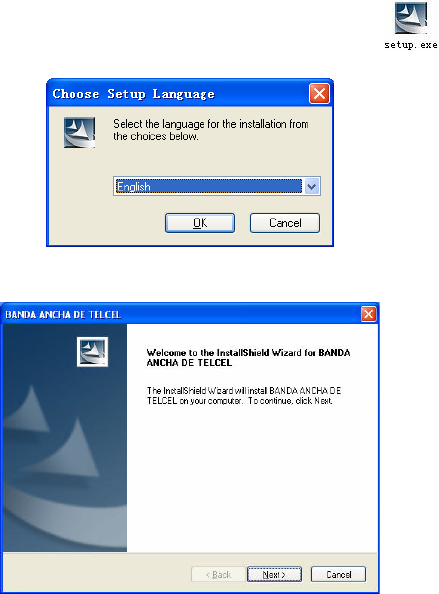
6
2.3 Software Installation
Install the software before inserting your card into your PC.
Insert the CD into your CD-ROM drive. The installation should auto start.
If the PC doesn’t launch the installation automatically please run
on the CD.
Choose Setup Language, and then click OK to continue.
Click Next to continue.
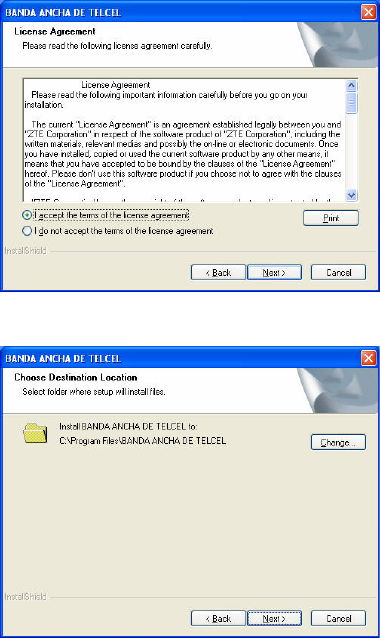
7
Select “I accept…” and click Next to continue.
You can change the installation folder by pressing Change, and then
click Next to continue.
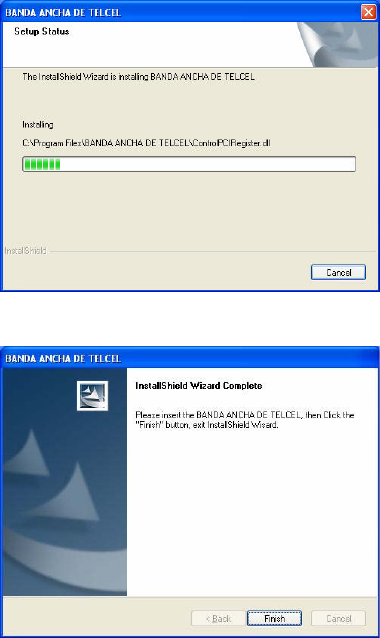
8
Installation is in progress.
Click Finish to complete the software installation.
2.4 Running the Application
When the software installation is finished make sure your SIM/USIM
card is inserted correctly in the ZTE MF332 HSDPA/EDGE Card then
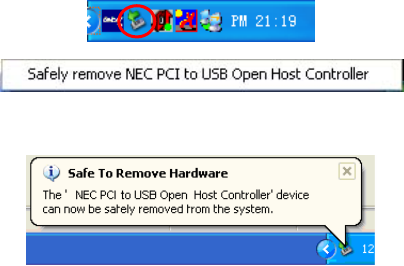
9
insert the data card into the PC slot and allow Windows to complete the
New Hardware Installation. Launch the application software by
double-clicking on the desktop icon or select Start → Programs →
BANDA ANCHA DE TELCEL → BANDA ANCHA DE TELCEL.
2.5 Safe Removal from your system
In order to safely remove the data card from your system, right click the
service provider logo on the task bar select “Power Off Data Card” and
close the software application then left click on the icon in the taskbar as
shown:
Click the item in the above dialog box to get the following message:
Now, you can pull out the data card safely.
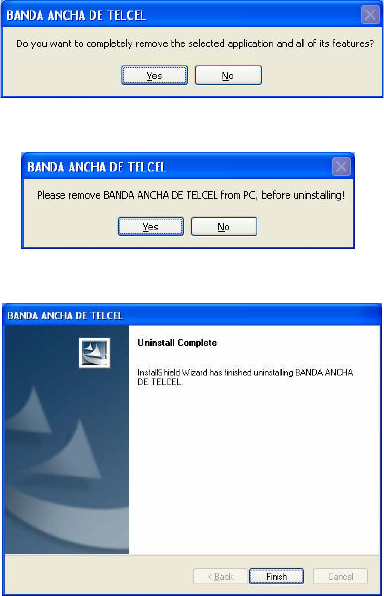
10
2.6 Software Uninstallation Process
If you need to uninstall the software first close the application program
then click Start → Programs → BANDA ANCHA DE TELCEL →
Uninstall.
Follow the prompts on screen:
Click Yes to continue.
Remove the Data Card from PC, and then click Yes to continue.
11
Click Finish and complete the application software removal.
2.7 Hardware Set Up
First install the CD Software See 2.3 above.
1. Inserting SIM/USIM card into the data card
Before inserting the data card into your PC you need to fit your
SIM/USIM card. Insert the SIM/USIM card with the gold contacts facing
downwards into the slot on the side of the data card.
2. Inserting data card into your PC
Insert the data card into the PCMCIA slot and push firmly home. The
LED indicates when the data card is properly inserted.
3. Earphone Connection
In order to send or receive voice calls please plug the earphone supplied
into the socket on the data card.
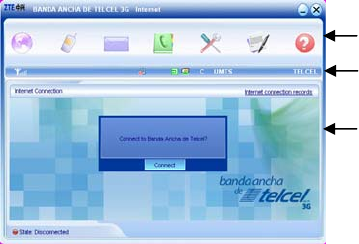
12
3 Using the Software Application
3.1 Software Introduction
Launch the software by double clicking on the desktop icon. The connect
interface is displayed:
Press Connect to connect to the default service.
The screen is divided into three sections. The top section contains the
function buttons for quick connection, messages and set up. The next
bar contains network and card status and is called the System
Information Area. The remaining space is the user area and varies
depending on application.
System Information Area
User Area
Functions Area

13
1. Functions Area:
The function buttons are straight forward and intuitive providing quick
access to the most common features of the data card.
Connect to the Internet
Dial or receive a call.
Send or view SMS Messages
Save and view your contacts list
Configure the data card settings
View your call records
System help

14
2. System Information Area
The system information area reports the status of the data card, signal
strength, missed calls, messages etc.
Network signal strength indicator.
You have incoming call or missed calls
There are new SMS messages
Data card disconnected from the Internet
Data card connected to the Internet
SIM/USIM card is roaming
P indicates packet-switched service. C indicates circuit
switched service
Data card has been inserted into the computer
Data card has not been inserted into the computer
Data card is offline
SIM/USIM card is present and active
SIM/USIM card has not been inserted or the SIM/USIM card is
not correct
Current network service type, i.e. WCDMA or GPRS/GSM
Name of current service provider
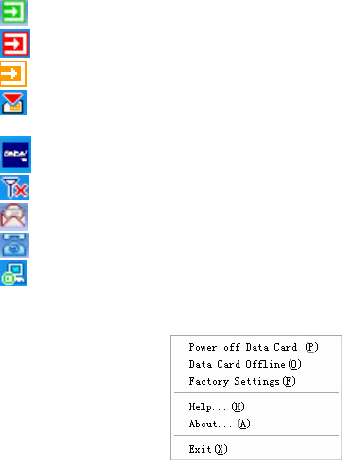
15
System Information - Minimized Icons on task bar
When the window is minimized, the system icons display on the taskbar.
Double click the icon to re-size the display.
1. Taskbar Icons’ Description
Data card has been inserted into the computer.
Data card has not been inserted into the computer.
Data card is offline.
SIM/USIM card has not been inserted or the SIM/USIM card is
not correct.
Data card is working normally, idle status.
No network signal.
New Message.
New incoming call or missed calls.
Green indicates successful connection to the internet.
2. Taskbar Right Click Options:
Power off Data Card: The card is switched off. To restart the card you
need to remove and re-insert it into the PC slot.
Data Card Offline: Take the data card offline. You cannot receive calls in
this state. You can re-start the card by right clicking on the task bar and
selecting Data card Online.
Factory Settings: Restore factory defaults (note this does not erase
your contacts, SMS or call records).
Help: View system help.
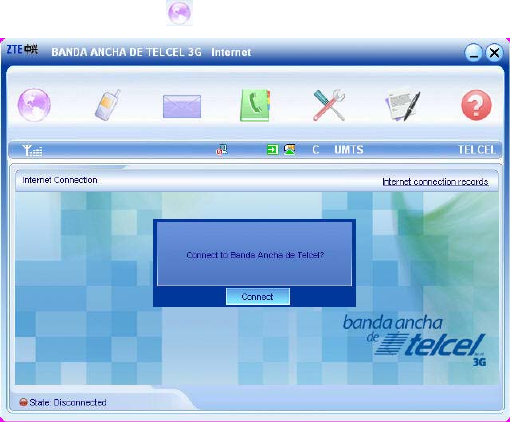
16
About: View application software and hardware versions.
Exit: Close the application interface and stop using the data card.
3.2 Connecting to the Internet
Click the Internet icon and press Connect to confirm.
Notes
• For connecting to the Internet, you should set the right profile file at
first. See 3.9 section 1.
• Once you are connected, run Internet Explorer or other applications
in the usual way.
• You can still receive and make calls while you are connected to the
net.
• The connected icon appears on the taskbar:
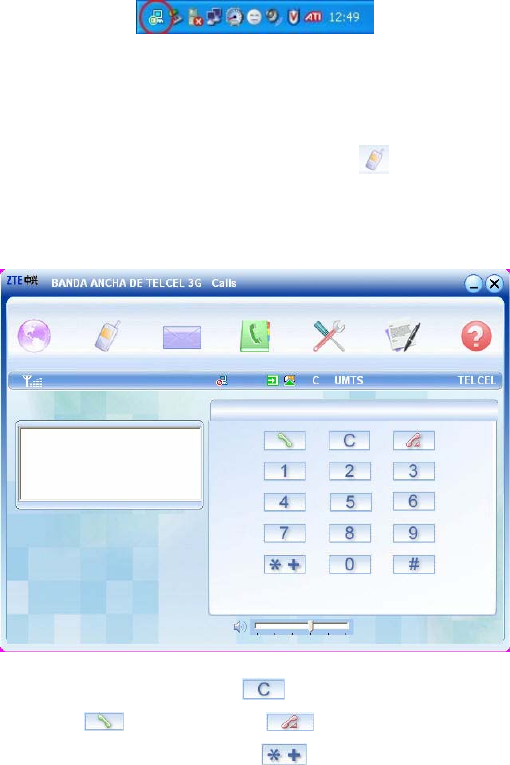
17
• Press Disconnect to terminate the connection.
3.3 Making a Call
Connect your headset and click the Calls icon to make a call.
Enter the telephone number using the keypad on the screen or by typing
on the keyboard. You can also select numbers from the calls list or from
your contacts.
Notes
• If you make a mistake press to clear.
• Press to send and press to end a call.
• For international calls, press twice for the international

18
prefix “+”.
3.4 Answering an Incoming Call
When you get an incoming call “Incoming Call” appears on the screen
and an alert will ring on the PC. The incoming number (if available) will
show in the left and the green light on the data card flashes continually.
Press to answer or press to reject. You can also press
the button on the headset to answer the call.
3.5 Other Call Functions
1. Volume Adjustment:
You can adjust the headphone volume by using the slider .
2. Redialing:
In standby status press to bring up the dialed calls list, select the
required number and press the Dial button.
3. Making an Emergency call:
Even without SIM/USIM card you still can make emergency calls. Enter
the number on the keyboard or by clicking on the number keypad.
4. Dialing when surfing on the Internet:
When surfing on the Internet you also can dial up and make voice calls
(subject to network support). Click to enter the calls interface.
5. Viewing missed calls:
If there is a missed call press the icon to view the details.
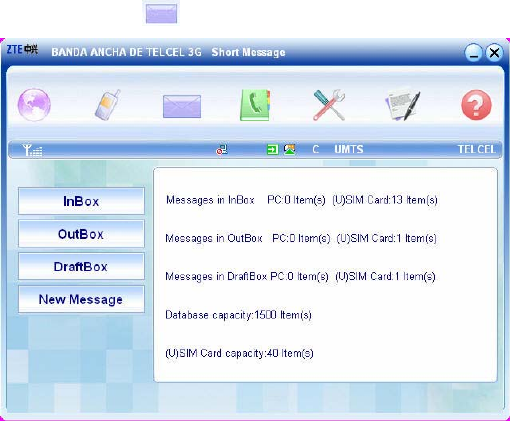
19
3.6 SMS Messages
Click the SMS icon to use the SMS interface.
Then click on the respective button to view:
InBox: Contains received SMS messages.
OutBox: Contains sent SMS messages.
DraftBox: Contains draft messages and messages that failed to send.
After clicking on the respective box use the buttons at the bottom of the
window to Read, Reply, Forward, Move, Delete, Save or Cancel
message(s).
3.7 Create a New Message
Click New Message. Enter the recipient’s number or select a number
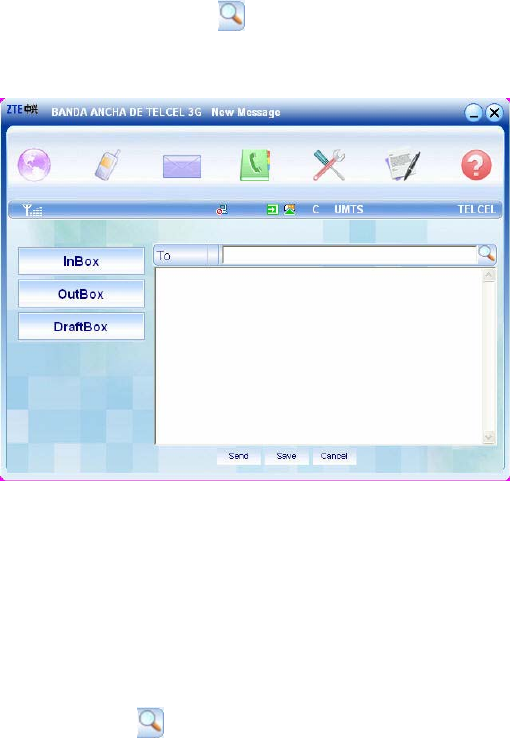
20
from your contacts by pressing . Type your message then click Send
and follow the prompts. After sending the SMS will be saved in the
OutBox. If it fails to send the message will be saved in the Draft Box.
Notes
• SMS messages are limited to 765 characters including spaces etc.
• You can send messages while using the internet. Just click on the
SMS icon and create a new message as above.
• You can add multiple recipients using “;” between each number.
New Message - Contacts List
After pressing the search button you can enter single or multiple
contacts by selecting the check box on the left hand side then press the
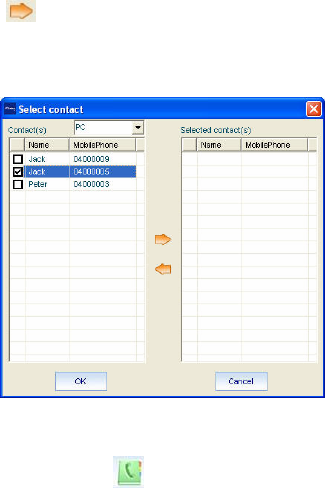
21
arrow button to move it to the right box. When you press OK the
contacts will show in the new message window.
3.8 Phone Book
Click the Phone Book icon to use the phone book interface. The
Folder window indicates if the contacts are stored on the PC or the
SIM/USIM card.
1. To Add a New Contact
Click New, New Contact. Enter the required information then select OK
to finish.
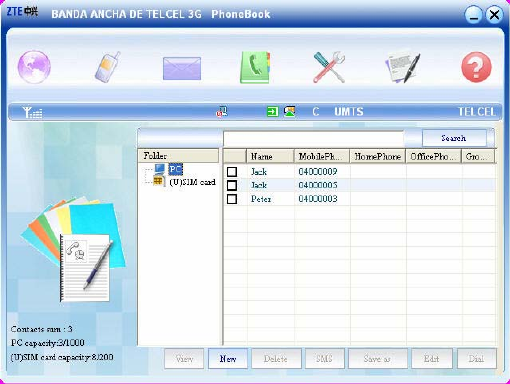
22
2. New Groups
Contacts can be stored in different groups. You can create and name
your own groups using the New Group button.
3. Searching and Editing Records
Type any part of the record into the entry bar and click Search. When a
record is selected you can View, Delete, SMS, Save as, Edit or Dial the
selected record using the corresponding buttons.
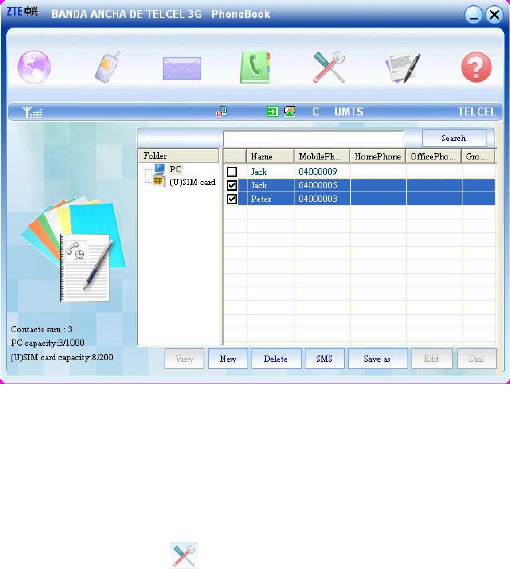
23
4. Copying contacts from SIM/USIM card to PC
Use the check boxes to select your required contact on the SIM/USIM
card then drag them up to the folder section and drop them on PC.
The highlighted contacts will be copied from the card to the PC.
3.9 Settings
Click the Settings icon to use the settings interface.
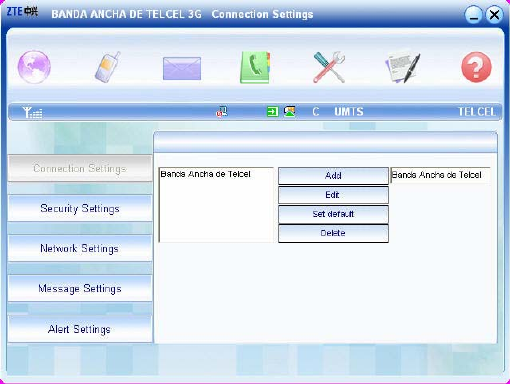
24
1. Connection Settings
There is one default profile provided by service provider in the settings
configuration. You can view the details and set it as the default file.
Consult service provider for more details.
For other profile, you can Add, Delete, Edit, and Set default.
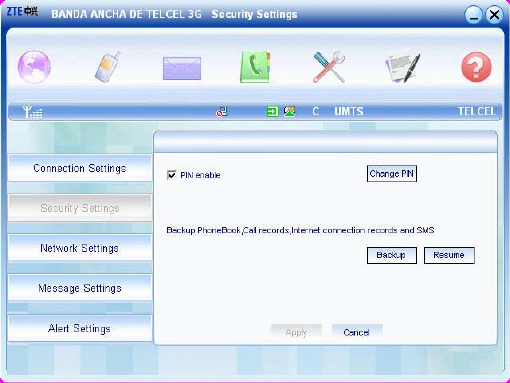
25
2. Security Settings
• PIN Enable, Change PIN – Enable PIN protection and change your
PIN Number.
• Backup Phone Book, Call records, Internet connection records
and SMS – Store and restore back-ups on your PC.
Notes
The PIN number for the card is provided by service provider. If you
change or lock up your PIN number you will need to contact service
provider to get a PUK code.
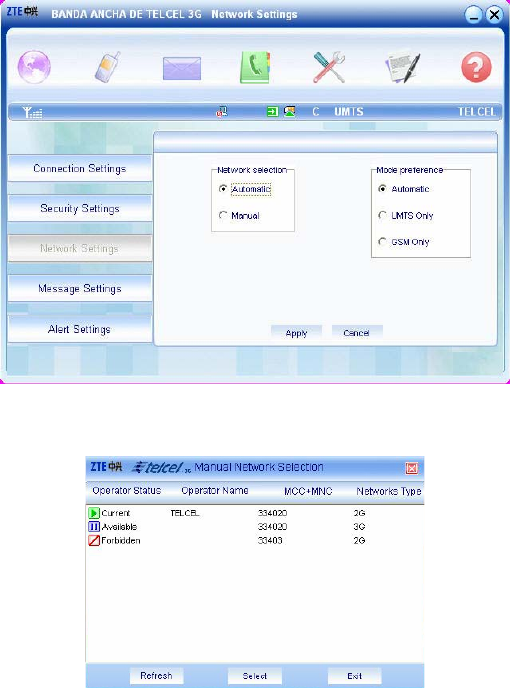
26
3. Network Settings
The network selection can be set to Automatic or Manual.
When you select Manual the card will search and display available
networks.
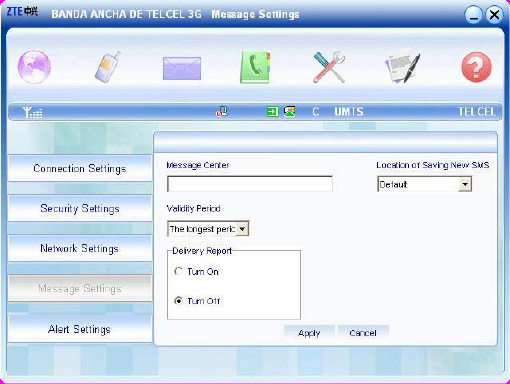
27
Notes
• It is best to leave the default settings on automatic. The software
will negotiate the best available connection depending on your
network coverage.
• Select International Roaming to enable use on overseas networks.
4. Message Settings
You can set the Message Center number (preset, no need to change)
and change the Validity Period, SMS Save Location and Delivery
Report.
Note:
When delivery report is turned on you get a message back from the
message center confirming when your SMS is delivered.
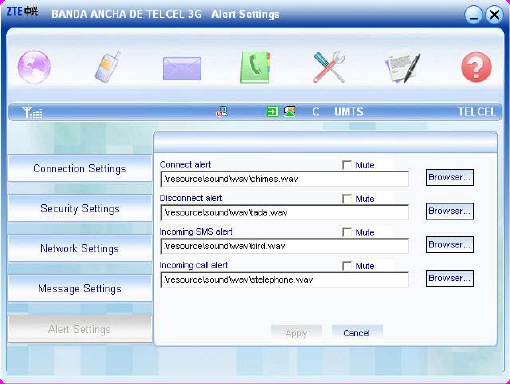
28
5. Alert settings
You can set different sounds or mute each alert for Connect alert,
Disconnect alert, Incoming SMS alert and Incoming call alert on the PC.
Use Browse to select alternative sounds.
6. Factory settings
If you change any of your settings and manage to disable your
connection please try the factory settings button on the task bar. Move
your mouse over the icon on the task bar and right click to select the
Factory Settings option. Restoring the factory settings does not erase
your phone book, saved messages or call records.
This menu is only available when the card is inserted into the PC slot.
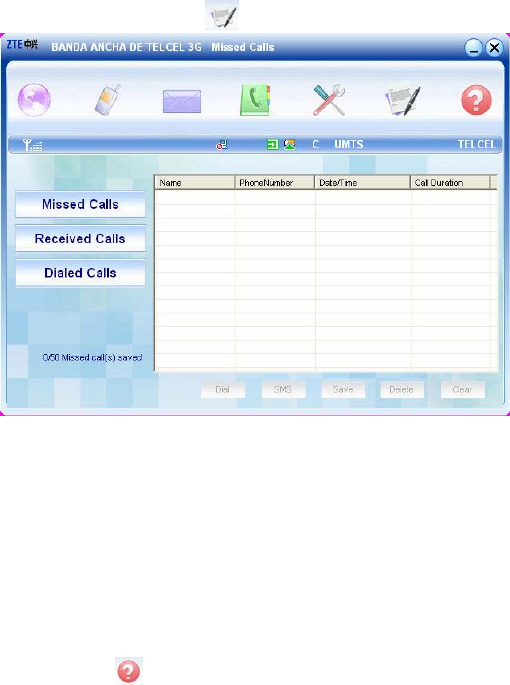
29
3.10 Call Records
Click the Call Records icon to use the call records interface.
When a record is selected you can Dial, send SMS, Save, and Delete.
Use the Clear button to clear all records.
Note
When more than 50 records are exceeded the system automatically
deletes old records.
3.11 Help
Click Help icon to switch to the help interface. Under Help you can
get an introduction to the data card functions, installation and usage
guide.
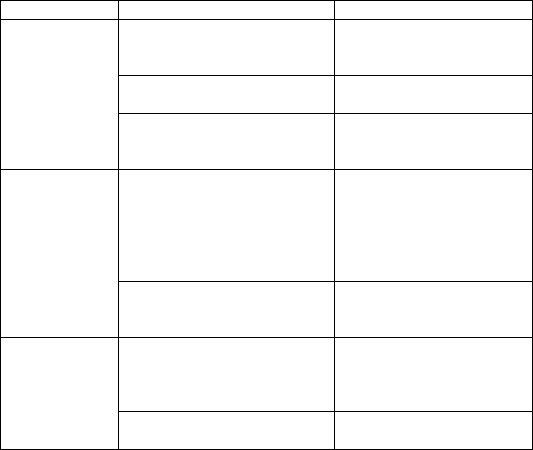
30
4 FAQ & Answers
If you experience any problems with your data card please check the
FAQ section below. If the problems still exists consult your service
provider or ring the customer service number on the warranty card.
If the card or the software are not responding first switch the card off line,
then remove and re-insert your card, close and restart the software
application. Finally try rebooting the PC.
Description Possible reasons Solution
You are in an area where
there is no network
coverage.
Move location until you
get better reception.
The data card isn’t inserted
properly. Pull out and insert the
data card again.
After
restarting the
PC, there is
still no signal. The SIM/USIM card isn’t
inserted correctly, eg
upside-down or reversed.
Insert the SIM/USIM
card correctly.
The installation program
did not install properly. Run the installation
program first, then insert
the data card. Run Setup
from the CD and choose
‘Repair’ then re-insert
the data card.
During
installation
the PC does
not find the
data card. The data card isn’t inserted
correctly. Restart the computer,
and insert the data card
again.
The SMS centre number
isn’t correct. Check with your service
provider and re-enter the
number or restore
factory defaults.
Message
send fails. The network is busy or is
down for other reasons. Try again later.
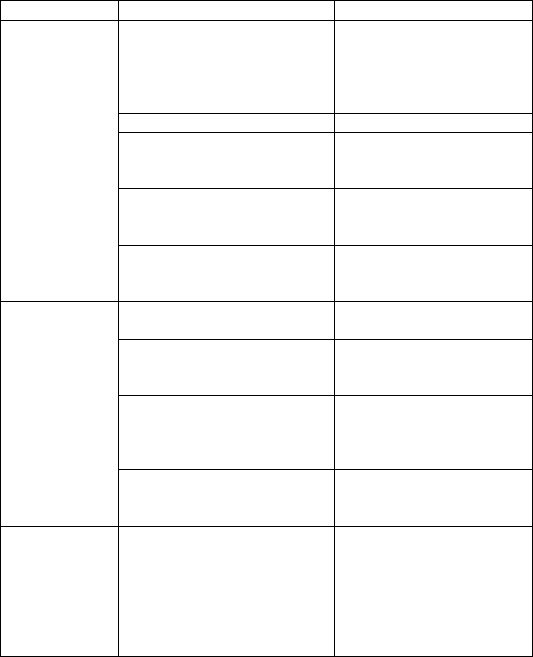
31
Description Possible reasons Solution
You are in an area where
there is no or poor network
coverage such as deep in a
building or underground in
a car park etc.
Move location until you
get better reception.
The network is busy. Try again later.
The dialed number or the
APN in the user config files
is incorrect.
Check the number.
Check the APN, restore
defaults.
The HSDPA/EDGE data
fails. Network problem.
Please check with your
service provider.
Data
connection
fails.
The manual configurations
are set wrong. Change your network
settings to automatic.
Restore defaults.
After connection, there is
no data transfer. Check your APN
settings.
Internet Explorer is
outdated. You should upgrade your
Internet Explorer to be
version 6.0 or higher.
It is possible you have a
virus infecting your PC. Use anti-virus software
to check and restore
your system.
Connected to
the Internet,
but cannot
open any
web pages.
You have connected to
another APN which cannot
connect to the Internet.
Check your APN
settings. Restore
defaults.
Cannot use
the data card
after deleting
some
hardware.
The wrong hardware has
been deleted affecting the
data card.
Pull out and insert the
data card again to restart
the installation software.
Run Setup from the CD.

32
Description Possible reasons Solution
The window
disappears
when you
minimize it.
This is normal. The
application is still running in
the background and can be
accessed through the task
bar.
Double click the icon on
the task bar to re-size
the window.
Incoming call
does not
show phone
number.
The incoming call has
blocked their number, or
the network does not
support this.
Problem is with the other
party or the network.
No warning
tones.
Sound card is not installed,
the volume is too low or the
sound is muted.
Check the sound card
settings and adjust the
volume. Check Settings,
Alert Settings.
Cannot
receive calls
when
connected to
Internet.
Network problem. Please check with your
service provider.
The
installation
did not
complete
successfully.
Card was inserted before
installation was complete.
Drivers are corrupted, other
Windows problems.
Remove and replace the
card. Check ‘Device
Manager’ in Windows
and re-install the drivers
Run Setup from the CD
and choose ‘Repair’.
33
5 Environmental Statement
ZTE is committed to saving and protecting the natural environment and
asks you to continue this commitment when you dispose of your
equipment. Your ZTE MF332 HSDPA/EDGE Card is made using the
latest manufacturing techniques and environmental standards to reduce
waste and hazards to the environment. However at the end of life of the
equipment the manufacturer recommends that you return the data card
and accessories to your nearest re-cycling depot or send it to our
recycling agent below. Valuable materials such as gold, silver, and
copper can be recovered from the unit. Any toxic materials will be
prevented from entering the environment and the waste materials will be
recycled.